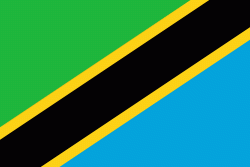Wete District (Wete District)
Wete District (Wilaya ya Wete in Swahili) is one of two administrative districts of Pemba North Region in Tanzania. The district covers an area of 295 km2. The district is comparable in size to the land area of Maldives. The district has a water border to the east and west by the Indian Ocean. The district is bordered to the north by Micheweni District. The district seat (capital) is the town of Wete. According to the 2012 census, the district has a total population of 107,916.
Wete District is on Pemba Island and nearby islands in the Indian Ocean off the Pemba channel. The islands themselves are composed of sedimentary rocks deposited during the Neogene and Quaternary consisting of mostly limestones and sandstones with marls and some shale, as well as unconsolidated sands and clays. The sediments are nearly flat laying producing a gently undulating and rolling plain.
Wete District is on Pemba Island and nearby islands in the Indian Ocean off the Pemba channel. The islands themselves are composed of sedimentary rocks deposited during the Neogene and Quaternary consisting of mostly limestones and sandstones with marls and some shale, as well as unconsolidated sands and clays. The sediments are nearly flat laying producing a gently undulating and rolling plain.
Map - Wete District (Wete District)
Map
Country - Tanzania
 |
 |
| Flag of Tanzania | |
Many important hominid fossils have been found in Tanzania, such as 6-million-year-old Pliocene hominid fossils. The genus Australopithecus ranged across Africa between 4 and 2 million years ago, and the oldest remains of the genus Homo are found near Lake Olduvai. Following the rise of Homo erectus 1.8 million years ago, humanity spread all over the Old World, and later in the New World and Australia under the species Homo sapiens. H. sapiens also overtook Africa and absorbed the older species of humanity. Later in the Stone and Bronze Age, prehistoric migrations into Tanzania included Southern Cushitic speakers who moved south from present-day Ethiopia; Eastern Cushitic people who moved into Tanzania from north of Lake Turkana about 2,000 and 4,000 years ago; and the Southern Nilotes, including the Datoog, who originated from the present-day South Sudan–Ethiopia border region between 2,900 and 2,400 years ago. These movements took place at about the same time as the settlement of the Mashariki Bantu from West Africa in the Lake Victoria and Lake Tanganyika areas. They subsequently migrated across the rest of Tanzania between 2,300 and 1,700 years ago.
Currency / Language
| ISO | Currency | Symbol | Significant figures |
|---|---|---|---|
| TZS | Tanzanian shilling | Sh | 2 |
| ISO | Language |
|---|---|
| AR | Arabic language |
| EN | English language |















